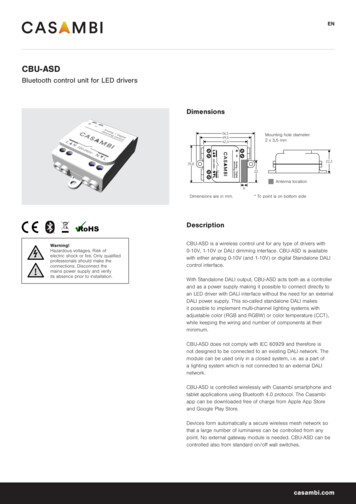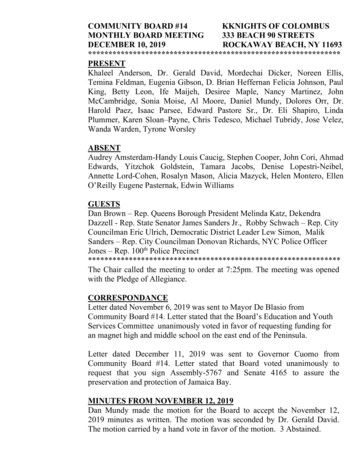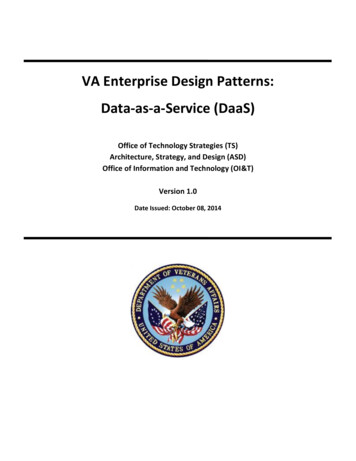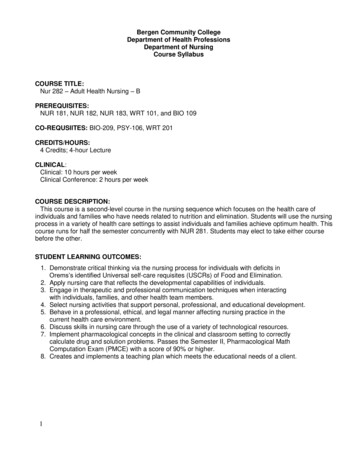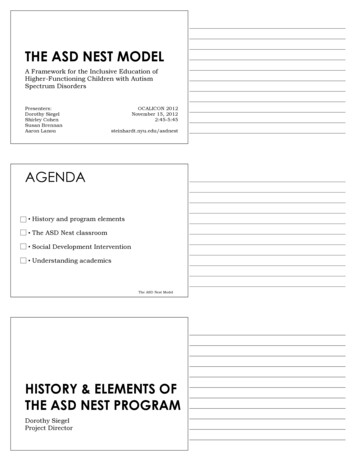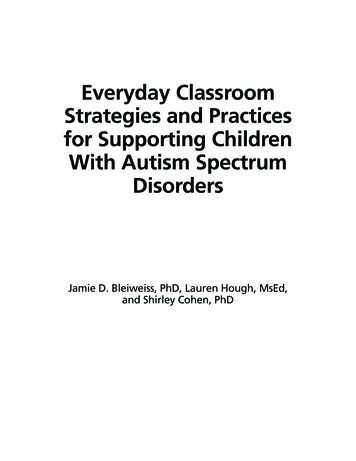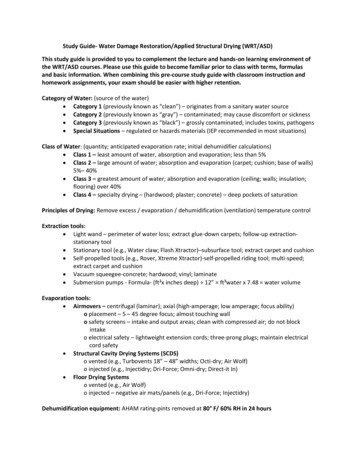
Transcription
Study Guide- Water Damage Restoration/Applied Structural Drying (WRT/ASD)This study guide is provided to you to complement the lecture and hands-on learning environment ofthe WRT/ASD courses. Please use this guide to become familiar prior to class with terms, formulasand basic information. When combining this pre-course study guide with classroom instruction andhomework assignments, your exam should be easier with higher retention.Category of Water: (source of the water) Category 1 (previously known as “clean”) – originates from a sanitary water source Category 2 (previously known as “gray”) – contaminated; may cause discomfort or sickness Category 3 (previously known as “black”) – grossly contaminated; includes toxins, pathogens Special Situations – regulated or hazards materials (IEP recommended in most situations)Class of Water: (quantity; anticipated evaporation rate; initial dehumidifier calculations) Class 1 – least amount of water, absorption and evaporation; less than 5% Class 2 – large amount of water; absorption and evaporation (carpet; cushion; base of walls)5%– 40% Class 3 – greatest amount of water; absorption and evaporation (ceiling; walls; insulation;flooring) over 40% Class 4 – specialty drying – (hardwood; plaster; concrete) – deep pockets of saturationPrinciples of Drying: Remove excess / evaporation / dehumidification (ventilation) temperature controlExtraction tools: Light wand – perimeter of water loss; extract glue-down carpets; follow-up extractionstationary tool Stationary tool (e.g., Water claw; Flash Xtractor)–subsurface tool; extract carpet and cushion Self-propelled tools (e.g., Rover, Xtreme Xtractor)-self-propelled riding tool; multi-speed;extract carpet and cushion Vacuum squeegee-concrete; hardwood; vinyl; laminate Submersion pumps - Formula- (ft²x inches deep) 12” ft³water x 7.48 water volumeEvaporation tools: Airmovers – centrifugal (laminar); axial (high-amperage; low amperage; focus ability)ο placement – 5 – 45 degree focus; almost touching wallο safety screens – intake and output areas; clean with compressed air; do not blockintakeο electrical safety – lightweight extension cords; three-prong plugs; maintain electricalcord safety Structural Cavity Drying Systems (SCDS)ο vented (e.g., Turbovents 18” – 48” widths; Octi-dry; Air Wolf)ο injected (e.g., Injectidry; Dri-Force; Omni-dry; Direct-it In) Floor Drying Systemsο vented (e.g., Air Wolf)ο injected – negative air mats/panels (e.g., Dri-Force; Injectidry)Dehumidification equipment: AHAM rating-pints removed at 80 F/ 60% RH in 24 hours
TypeType DehumidifierStandard refrigerantConventionalLow Grain RefrigerantDesiccant (with silica gel) Reduced PerformanceTemperature68 F.33 F.40 F.32 F.Relative Humidity60%40%30%10% - belowHumidity Ratio (gpp)55 - 6055 - 6032 - 3510 – 15 - belowRefrigerants – Most efficient operating conditions 70 - 90 F. (LGR, most energy efficient)Desiccants- most efficient with incoming air from coolest/driest air possible; capable ofcreating differentials; produces low humidity ratio (gpp) advised to dry Class 4 materialsUses- closed-drying environments; multiple layers of materials; security limitations; highoutside (and inside) humidity conditions; no ventilation ports; basement areasInitial dehumidification calculations (psychrometric readings dictate requirements after first day)TypeConventionalLGRDesiccantClass 11001001 ACH( 60)Class 240502 ACH( 30)Class 330403 ACH( 20)Class 4N/A403 ACH( 20)Electrical / Heat / Energy: Amperes (amperage or “amps”) – the amount of electricity (current) flowing in a circuitVoltage- the force of electricity flow in a circuitWatts- the amount of electricity an electrical device uses when operatingBritish Thermal Units (BTUs)- heat generated by electrical device Formula- amps x volts x 3.4 British Thermal Units (Btu) per hour HVAC- unit removes 12,000 Btu per tonResidential v. commercial- generally, residential 15 amp / commercial 20 amp220 splitters- use where there is limited amperage or fusesUse no more than two, five-amp air movers per 100 ft., 12-gauge extension cordPower Consumption formula- volts x amps x 24 hours watts 1000 kw x cost per kw perday
Inspection equipment: Moisture sensor – senses moisture in materials over 17% MC; helps determine perimeter ofwater damage; unable to determine which layer is wet or when dryThermo-hygrometer – determines temperature / RH in all required atmospheric areas ofinspection; helps determine open or closed drying systems; further determinesdehumidification requirements after initial placementMoisture meters – invasive and non-invasive; determines moisture content; establish,monitor, and determine when dry standards are metMiscellaneous – infrared camera and thermometer; manometer; borescope; data loggerChemicals / blockers (antimicrobial biocides) Sterilizer; disinfectant; sanitizer Provide written informed consent to customer; advise occupants to leave duringapplications; document Government-registered disinfectants – document application details; apply only per labeldirections EPA – Environmental Protection Agency (U.S. federal agency with regulatory control overbiocides) F.I.F.R.A – Federal Insecticide, Fungicide and Rodenticide Act – U.S. federal regulationsadministered by EPAFloorcovering carpet: Installation methods – stretch-in, direct glue-down, double glue-down Drying methods – in-place, full float, partial float Construction – woven – Axminster, Wilton; usually natural fibers; tufted – primarilysynthetic Delamination – separation of primary – secondary backings; laminate strength loss up to85% when wet (causes – over aggressive extraction; “flapping” while floating; impropercushion; urine; folding) Category 3 – must remove and dispose; IEP may be required for testing; if Category 2 – hotwater extraction of carpetFloorcovering cushion (also known as padding; underlay) Types – foam (prime, bonded urethane); rubber, felt (hair/jute, synthetic); porous and nonporous Category 2 and 3 – must remove and properly disposeFloorcovering wood (strip wood, plank wood, engineered – laminated wood, parquet) Non-destructive (non- rotting) fungal growth – over 16% MC Destructive (wood-rotting) fungal growth – over 20% MC Fiber saturation (“wet rot”) 25 – 30% MC Damages from moisture – (cupping; crowning; buckling; heaving) Dry with 2 – 4 percentage points of EMC – dry goalFloorcovering (laminate; resilient, ceramic tile)
Limitations (trapped water, potential asbestos, ceramic tile – sealed grout; trapped water)Layers of floorcovering; dry flooring as a systemMicrobiology (fungus; bacteria; virus) Conditions for growthο organic food source (cellulose)ο moisture (or high humidity)ο temperature (most profile 68-86 F. / 20-30 C.)ο time (some 1-2 days; others up to 10-12 days in chronic conditions) ANSI/IICRC S520 - Standard and Reference Guide for Professional Mold Remediation Indoor Environmental Professional (IEP) – specialized experts may be required Mycotoxin – a potentially harmful metabolite produced by some fungi, especially molds Endotoxin – a portion of the outer cell wall of some gram-negative bacteria. When ingestedor respired, endotoxins can cause fever, changes in white blood cell counts, increasedairway resistance, shock or even death.Psychrometry definitions: Psychrometry – study of the relationship between air, humidity and temperature and theireffect on various materials and comfort levels Psychrometric chart – chart consisting of lines and curves that shows the relationshipbetween air volume, temperature and relative humidity, and from which a variety of otherinformation (humidity ratio-gpp, dew point, vapor pressure, etc.) relating to drying may bedetermined Dew point – the temperature at which humidity in air reaches saturation (100% RH) and willcondense from that air to form condensation or “dew” on surfaces Evaporation – the process of changing a liquid to a vapor Primary damage – damage sustained as a result of direct exposure with water Secondary damage – damage sustained from indirect or prolonged exposure to disastercontaminants Relative Humidity (RH) – the amount of moisture in a given volume of air, expressed as apercentage of the total moisture holding capacity of that volume of air, at a giventemperature. As temperature increases, humidity “relative” to the total air volumedecreases; conversely, as temperature decreases RH increases. Humidity ratio (previously known as specific humidity) – the weight of suspended moisturein air expressed in grains per pound (gpp) of dry air (14 cubic feet of dry air equals onepound). 7000 grains of water vapor equals one pound of water. As humidity ratio (specifichumidity) changes, there is corresponding change in vapor pressure on the surroundingenvironment. Grains of moisture per pound (gpp) – unit to measure humidity ratio (specific humidity), orthe weight of moisture in air, expressed in grains per pound (gpp) of dry air. Balanced drying – ideal drying situation in which the rate of evaporation is equal to orslightly less than the rate of dehumidification or ventilation. Dehumidification / ventilation – reducing (exchanging) moisture content of air Dry bulb temperature – temperature registered by a thermometer Hygroscopic – material that readily absorbs and retains moisture or water vapor from air inan attempt to reach equilibrium
Moisture content (MC) – weight or percentage of moisture in materials, as compared to theweight of oven-dried, like material. (Wood with 10% MC indicates that 100 pounds of thatwood contains 10 pounds of water and 90 pounds of wood).Permeance – a measure of water flow through material(s) of specific thicknessSublimation – phase-transition in which a solid is transformed into a gas while bypassing theintermediate liquid phase (e.g., dry ice; freeze drying).Vapor pressure – pressure on surfaces exerted by substances in a gaseous state; directlyrelated to (reduced through) dehumidification.Vapor barrier – material through which moisture can’t readily pass (perm factor of 1 orless).Saturation – point at which air or materials can absorb no more moisture; point at whichdrying stops; point at which air or materials can absorb no more moisture; point at whichdrying stops; point at which air temperature has reached dew point (100 RH).Grain Depression- reduction of humidity ratio (grains; gpp) as noted in difference fromambient air to output on dehumidifier, and as well noted in other area differentials (e.g.,inside air-outside air: affected air- HVAC register output) showing removal.Balanced drying characteristics: Humidity, airflow and temperature “HAT” work together and when managed, enableachieving target time for drying “HAT” all influence movement toward equilibrium-wet seeks dry; hot seeks cold; high vaporpressure seeks low vapor pressure Vapor pressure is directly related to humidity ratio/specific humidity and dew point As heat is applied to a material, energy is added; raising the temperature of a wet materialincreases the rate of evaporation, further releasing moisture from the material, changingthe material’s vapor pressure The greater the difference between ambient temperature and dew point temperature, thegreater the potential for faster and more efficient drying Open drying-intentionally exchanging indoor with outdoor air without using dehumidifiers requires constant monitoring; above 80 F/27 C-microbial growth highly probable require rapid exhausting of wet air; concerns of reaching dew point temperature Closed drying-use of mechanical dehumidification Heat drying systems-creates lower RH; requires rapid and massive ventilation of wet air tothe exterior; increases rate of evaporation by increasing the surface temperature of wetmaterialsCommon items of all drying jobs: Proper authorization (contract, payment terms, responsible parties) Protect contents from further damages; identify primary, secondary, and pre-existingdamages Activation of site assets (ceiling fans, whole-house fans, exhaust vents, HVAC, open drying) Initiate extraction procedures (contain migrating water; remove excess moisture) Set up evaporation and dehumidification (ventilation) equipment to promote drying Customer communication; determine drying goals Project monitoring (frequency, activities, forms, documentation) Completion procedures (e.g., clean flooring, demolition, reconstruction, as required)
Common Industry Acronyms: AHAM- Association of Home Appliance Manufacturers ANSI- American National Standards Institute CRI- Carpet and Rug Institute NADCA- National Air Duct Cleanings Association OSHA- Occupational Safety and Health Administration PLRB- Property Loss Research Bureau SCRT (ISCT)- Society of Cleaning and Restoration Technicians WLI- Water Loss Institute ASHRAE- American Society of Heating, Refrigeration and Air Conditioning Engineers ACH- air exchanges per hour ACM- asbestos containing material BBP- bloodborne pathogen GPP- grains per pound (g/kg) – grams per kilogram HEPA filter- High Efficiency Particulate Air Filter IEP- indoor environmental professional LKQ- like kind and quality MVOC- Microbial Volatile Organic Compound EMC- equilibrium moisture content ERH- equilibrium relative humidity (compared to aʷ - water activity) MSDS- material safety data sheetCommon numbers used in for definitions and calculations: 40%- RH to attempt to achieve after 24-hours drying for “larger gas tank” 60%- RH hygroscopic materials start to readily take on humidity; microbial activity ERH 14- cubic feet in pound of dry air 7000- grains in pound of dry air 55-60- gpp where conventional dehumidifiers start to lose efficiency 32-35- gpp where LGR dehumidifiers start to lose efficiency 70-90 F. (21-30 C.)- temperature where refrigerant dehumidifiers have best performance 30%- RH where LGR dehumidifiers start to lose efficiency 1.5- Evaporation Potential number as minimum to use as goal with traditional dryingequipment 12,000- Btu removal action per ton of air conditioning per hour 80%- available power to use per NEC per amperage in circuit 1200- amount of times more effective of extraction to dehumidification in water removal 50-70- alternative recommended per sq. ft. for air mover placement 3/4” thickness of most hardwood planks; distance of reading with non-invasive moisturemeter 7.48- gallons per cubic foot of water depth 3 feet- distance of hardwood floor panels pulling from any direction as maximum distanceset up
100%- RH at saturation/dew point20%- rotting fungi growth IN wood (16% non-rotting fungi growth ON wood)Important DefinitionsThroughout this document the terms “shall”, “should”, and “recommend” are used to compareand contrast the different levels of importance attached to certain practices and procedures. It isimpractical to prescribe procedures intended to apply to every water damage situation. Incertain circumstances, deviation from portions of this Standard and Reference Guide may beappropriate. Carelessness is unacceptable and common sense and professional judgement are tobe exercised in all cases.shall: when the term shall is used in this document, it means that the practice orprocedure is mandatory due to natural law or regulatory requirements, includingoccupational, public health and other relevant laws, rules or regulations, and istherefore, a component of the accepted “standard of care” to be followed.should: when the term should is used in this document, they mean that the practice orprocedure is a component of the accepted “standard of care” to be followed,while not mandatory by regulatory requirements.recommend(ed): when the term recommend(ed) is used in this document, it means thatthe practice or procedure is advised or suggested, but not a component of the accepted“standard of care” to be followed.In addition, the terms “may” and “can” are also available to describe referenced practices orprocedures, and are defined as follows:may: when the term may is used in this document, it signifies permission expressed bythe document, and means that a referenced practice or procedure is permissible withinthe limits of this document, but is not a component of the accepted “standard of care”to be followed.can: when the term can is used in this document, it signifies an ability or possibilityopen to user of the document, and it means that a referenced practice or procedureis possible or capable of application, but is not a component of the accepted “standardof care” to be followed.
This study guide is provided to you to complement the lecture and hands-on learning environment of the WRT/ASD courses. Please use this guide to become familiar prior to class with terms, formulas . When combining this pre-course study guide with classroom instruction and homework assignments, your exam should be easier with higher retention.



